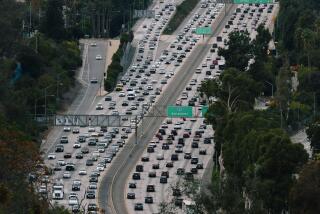CITY SMART / How to thrive in the urban environment of Southern California : Halloween Not October’s Only Scary Event
- Share via
There’s something about autumn and traffic accidents.
Bad driving? Try bad timing.
Experts say the return of standard time next weekend--when we turn our clocks back an hour--brings an increase in the number of accidents because motorists accustomed to driving in daylight during rush hour will suddenly find themselves driving at night.
Commuters notice the difference too.
Mauricio Baker, a caseworker at North Los Angeles County Regional Center, dreads tackling the roadways this time of year.
“People still act as if they’re driving during the day,” said Baker, 31, who commutes from his Culver City home to his office in Sepulveda. “They change lanes at short distances and expect people to be able to compensate for it, but when it’s dark it’s harder to judge traffic distance.”
That’s true, say researchers at the Insurance Institute for Highway Safety in Arlington, Va., who have found an increase in traffic accidents after the change from daylight-saving to standard time. In fact, numerous studies by several institutions around the country show that more drivers wind up in accidents at rush hour during fall and winter than at any other time of the year.
In a five-year nationwide study of fatal crashes in states that observe daylight-saving time, the institute found that there were 900 more fatal accidents between 5 p.m. and 7 p.m. on autumn weekdays than in the summer months, and that 81% of them involved pedestrians hit by cars.
“You’re talking about how well people can see things happen in front of them, and that affects the likelihood of a crash,” said Adrian Lund, senior vice president of research at the Insurance Institute.
Prof. Robert Hicks, a sleep expert at San Jose State University, said part of the problem is the readjustment of our body clocks.
“Disruptions in sleep make drivers less alert and possibly even more aggressive,” said Hicks, who has studied traffic safety and the changes between spring and fall from 1976 to 1978.
“I’m more convinced than ever that the change from one time to another is always disruptive to one’s body clock,” Hicks said. “I think fatigue is one of the factors.”
David Preusser, president of Preusser Research Group in Trumbull, Conn., which studies traffic safety and driving conditions, said the reasons are pretty simple: “When it’s dark, there tend to be more accidents. And when there are more people on the road and it’s dark, the number of accidents will increase.”
“In daylight savings there are more crashes in the morning, because that’s when it’s dark. But since there’s less traffic in the morning, there are fewer accidents than when you’re talking about driving in the afternoon,” he said.
The solution then, Preusser and others argue, should also be pretty straightforward: Do away with standard time.
The British did for a while, from 1968 to 1971 when British Summer Time became the norm. Complaints from other European countries squashed the British program. But the experiment proved effective in reducing accidents, by 2,700--or 1.2%--over the three-year period, according to the Transport Research Laboratory in the United Kingdom’s Department of Transportation.
Although the United States has instituted year-round daylight-saving time on various occasions--during World War II and the 1970s Arab oil embargo, for example--and sometimes lengthened the summer time period, federal officials have no plans to scrap the current system.
The best way to deal with it, said CHP Officer Rhett Price, is to find a way around it.
“People may have to begin using more precaution on the road and try to be more aware of what’s around them during those dusk hours,” Price said.
Baker said he has a better commuting strategy. “One of the things I’m going to try to do is leave as late or early as possible to avoid rush hour and the inevitable problem of dealing with traffic.”
More to Read
Sign up for Essential California
The most important California stories and recommendations in your inbox every morning.
You may occasionally receive promotional content from the Los Angeles Times.










